All Expansions Come to an End, Some Suddenly So
The National Bureau of Economic Research determined in early June that the expansion that began in June 2009 and lasted over a decade came to an end in March. The sudden and severe public response to the coronavirus resulted in a wide dispersion of forecast expectations and subsequent revisions. Real gross domestic product (GDP) in the first quarter was revised slightly lower to a decline of 5.0 percent annualized, and our forecast for second quarter GDP was little changed at -37.0 percent versus the -36.6 percent predicted last month. The slight adjustment to headline GDP expectation in the second quarter arises from significant revisions among the subcomponents; in particular, stronger consumer spending and fixed investment was offset by weaker net exports and business inventories. We revised downward our full-year growth forecast for 2020 by only one-tenth to -5.4 percent, while the 2021 growth expectation edged up only one-tenth to 5.3 percent. We consider the risks to our macro forecast to be balanced.
One of the largest sectoral revisions to our forecast this month was to residential fixed investment, which we increased by nearly 10 percentage points based on stronger incoming data. Home construction is now expected to be comparatively more resilient, though the projected Q2 decline will still be unprecedented. The same factors led us to upwardly revise our forecast for new and existing home sales in 2020. While existing sales declines to date have been sharp and in line with our expectations, new sales have surprised to the upside. Furthermore, recent weekly data suggests a strong short-term rebound in purchase activity. We believe this bounce to be temporary, in part due to constrained for-sale inventories. Still, we now expect new home sales to fall only 3 percent on an annual basis in 2020, while existing home sales are forecast to decline by 11 percent.
Strong incoming mortgage application data and our forecast for continued low mortgage rates led us to meaningfully revise upward our refinance originations forecast for 2020 by $254 billion to $1.8 trillion, a level eclipsing the refinance wave of 2012. Current consumer sentiment measures, recent purchase mortgage applications, and home listings data indicate more strength in demand than supply, which is currently supportive of home prices and mortgage activity. There is upside risk to our single-family sales and mortgage forecast if a significant shift in consumer preferences away from more densely populated areas persists over time.
The Good, The Bad, and the Ugly of Macro Data
May hiring data surprised to the upside, posting a gain of 2.5 million nonfarm jobs rather than the universally expected sharp decline. The rebound was welcome but small compared to the record 20.7 million jobs lost in April. It is also likely that a significant portion of the job gains can be attributed to the impact of the Paycheck Protection Program (PPP), which allows firms to bring laid-off workers back onto their payrolls. The hope is that the PPP combined with the additional policy support extended to small business will be sufficient to continue the growth trend as more state and local economies open up. Job gains were across most sectors, even the beleaguered service industry. The number of people working part-time but who would prefer full-time employment fell by 250,000 this month, a positive sign for labor demand. The unemployment rate declined by over a percentage point to 13.3 percent, though the Bureau of Labor Statistics estimates that number would be higher if not for a persistent measurement error that they are working to fix. Our forecast of a strong rebound in consumer spending in the third quarter implies, and depends on, a continued recovery in employment.
Another positive for consumer spending was a jump in vehicle sales in May to an annualized rate of 12.2 million. While sales were still down nearly 30 percent from the start of the year, incoming data like this suggest that pent up consumer demand is stronger than we were expecting last month. Support for spending could come from increasing real personal income, which rose 11.0 percent in April. While this was driven entirely by stimulus checks and expanded unemployment insurance, the personal saving rate did surge to 33.0 percent, the highest on record, providing consumers with the financial resources to increase their spending as the economy reopens. Consumer confidence edged up in May after plummeting in April, according to the Conference Board. While sentiment around the present situation continued to decline, the expectations component rose strongly past March and April levels. Given these factors, we revised upward our personal consumption expenditures (PCE) forecast by 2.3 and 5.9 percentage points in Q2 and Q3, respectively.
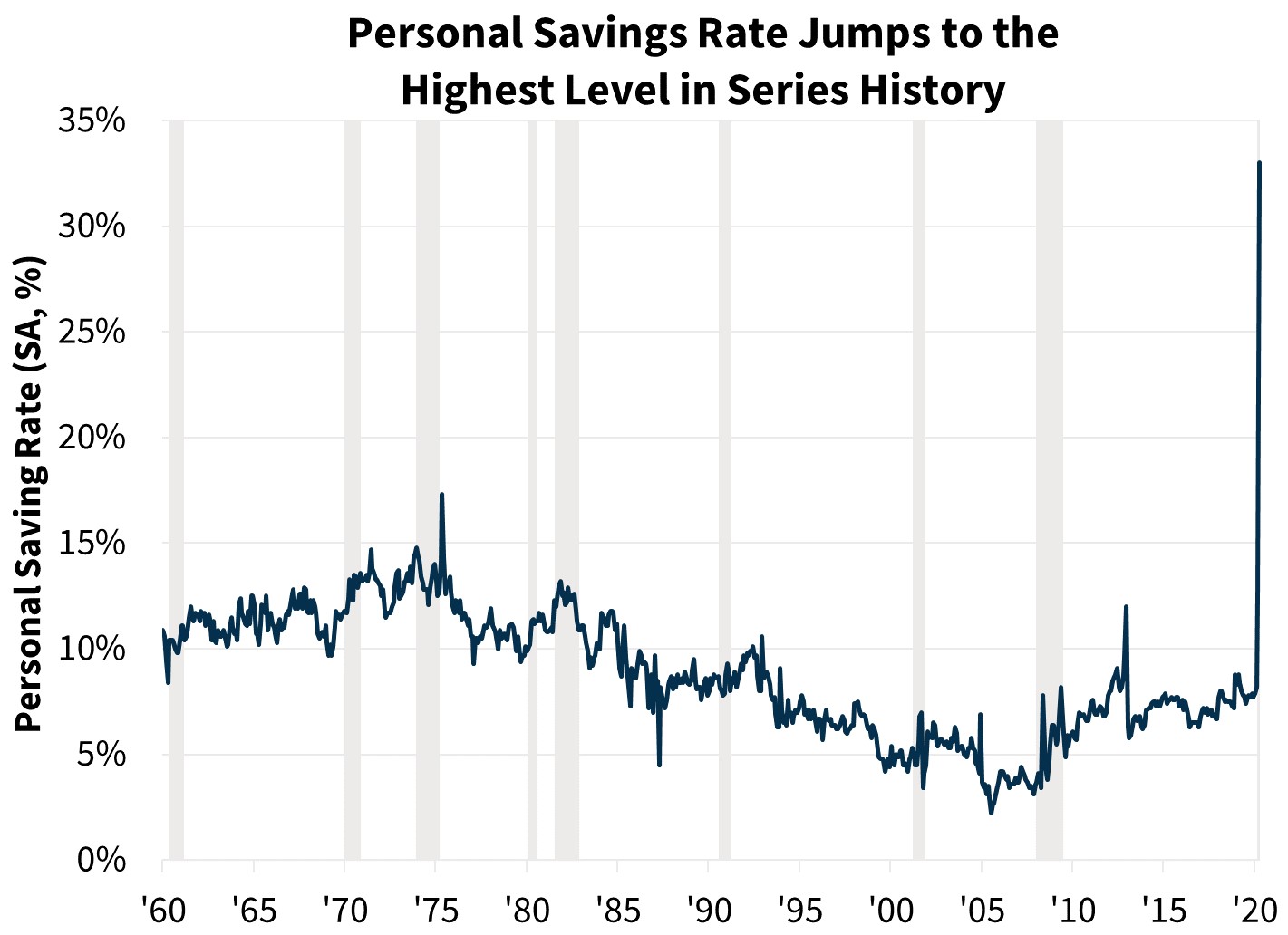
Businesses activity at the start of the second quarter was bleak. Factory orders fell 13.0 percent in April, following March’s decline of 11.0 percent. Transportation equipment orders were hit particularly hard, posting the largest decline in series’ history. Orders for nondurable goods also fell sharply. Moving into May, the data improved slightly with the ISM Manufacturing Index, a gauge of activity in the manufacturing sector, rising for the first time in four months and the Nonmanufacturing Index, a gauge of service sector activity, increasing for the first time since February, though they both remained in contraction territory. The National Federation for Independent Business’ May survey showed a small rebound from April’s sharp decline in business confidence. The percentage of firms expecting the economy to improve rose to 34 percent, the highest level since August 2018 and a good sign for business optimism. However, poor sales remained the single most important problem for the second straight month, and the net share of businesses expecting higher real sales in the next six months was -24 percent.
Financial markets have recently looked past weak economic data, cheered positive reports, and continued to improve. After troughing in late March, the S&P 500 has rebounded strongly, closing on June 10 approximately 43 percent higher than the recent low and approaching pre-pandemic levels. This has likely helped to bolster consumer spending and business confidence, as financial markets appear to be pricing in a strong economic recovery. While financial market volatility has been on the decline for the past two months, it remains historically elevated. The CBOE Volatility Index (VIX) from 2009 to 2020 (the prior expansion) averaged around 17 points, compared to 26 points during the first week of June. Another round of major financial market turbulence could occur if economic activity fails to meet the heightened expectations implied by financial markets, and therefore remains a downside risk to our forecast.
Uncertainties Regarding the Course of the Pandemic, and Consumer, Business, and Policy Response
Upside risk to our forecast includes a stronger bounce back in consumer spending as states reopen and consumer worries over the coronavirus dissipate. The labor market held up better than anticipated in May, and if June continues to show a recovery, personal income growth could be stronger than we currently forecast. To the downside, after trending down for weeks, the number of new coronavirus cases ticked up in the first week of June. As states continue to reopen, public health officials have shared concerns that new cases will increase again. The extent to which consumers, workers, and businesses retrench if there is a sustained second wave of infections is unknown and adds to the downside risk of our forecast.
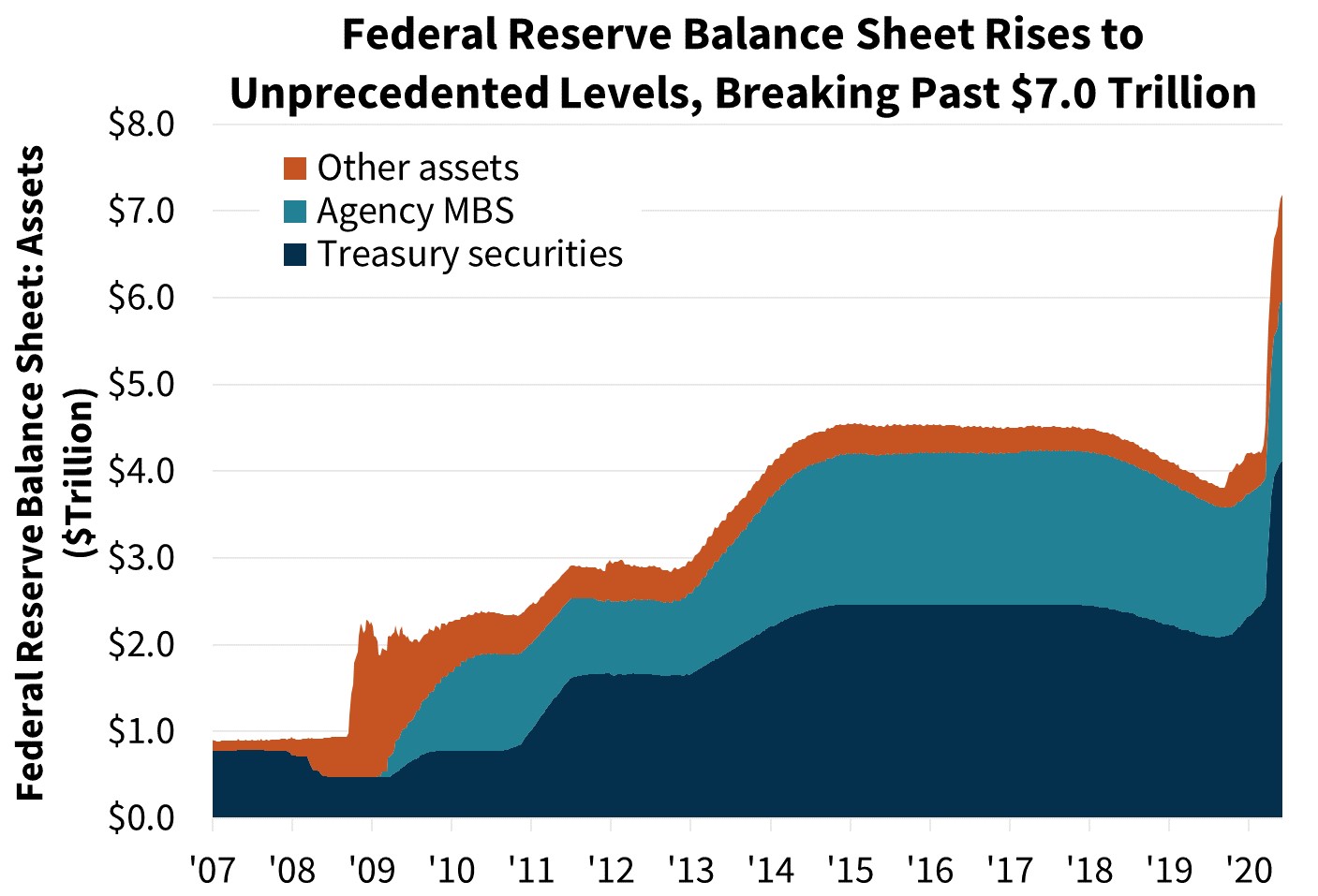
At its June meeting, the Federal Open Market Committee (FOMC) acknowledged improving financial markets, though it remained downbeat about the coronavirus’ impact on economic growth. The FOMC also released economic projections for the first time since last December, including its forecast that the federal funds rate will remain unchanged at the zero-lower bound through at least 2022. The FOMC also announced that it would continue asset purchases, putting a floor at $80 billion in Treasuries and $40 billion in mortgage-backed securities a month. The Federal Reserve balance sheet broke past $7.1 trillion in the first week of June, up from $4.2 trillion at the beginning of March.
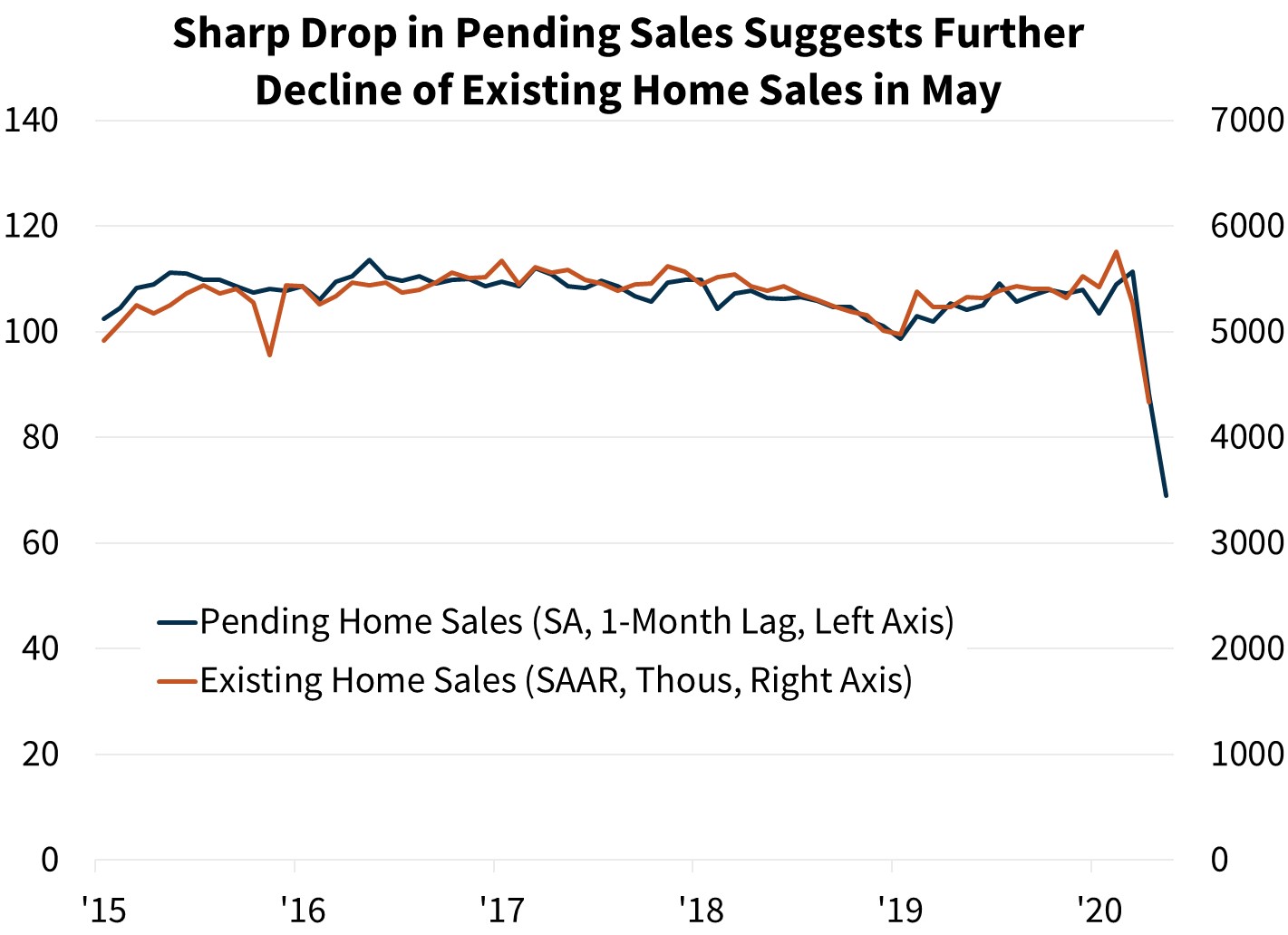
Home Sales Decline Sharply, Potential for Rebound
Housing activity continued to slow in April, mostly in line with our expectations. Existing home sales fell 18 percent to 4.3 million seasonally adjusted annualized units, the lowest level since September 2011. April pending sales, which lead existing home closings by about 30 to 45 days, fell 22 percent, suggesting a further sales pace decline in May. Home construction also slowed, with both single-family starts and permits declining around 25 percent in April to levels not seen since 2015.
More recently, mortgage applications have indicated a strong rebound in purchase activity. According to the Mortgage Bankers Association, applications for purchase mortgages rose for eight consecutive weeks, ending 12 percent higher than year-ago levels for the week of June 5. Many buyers who normally would have purchased homes in March and April were likely delayed due to the coronavirus pandemic, pushing the spring buying season later into the year. Due to recent strength in purchase applications, we upgraded our existing home sales forecast for the third quarter to 4.9 million annualized units, though this is still down 11.5 percent from the first quarter.
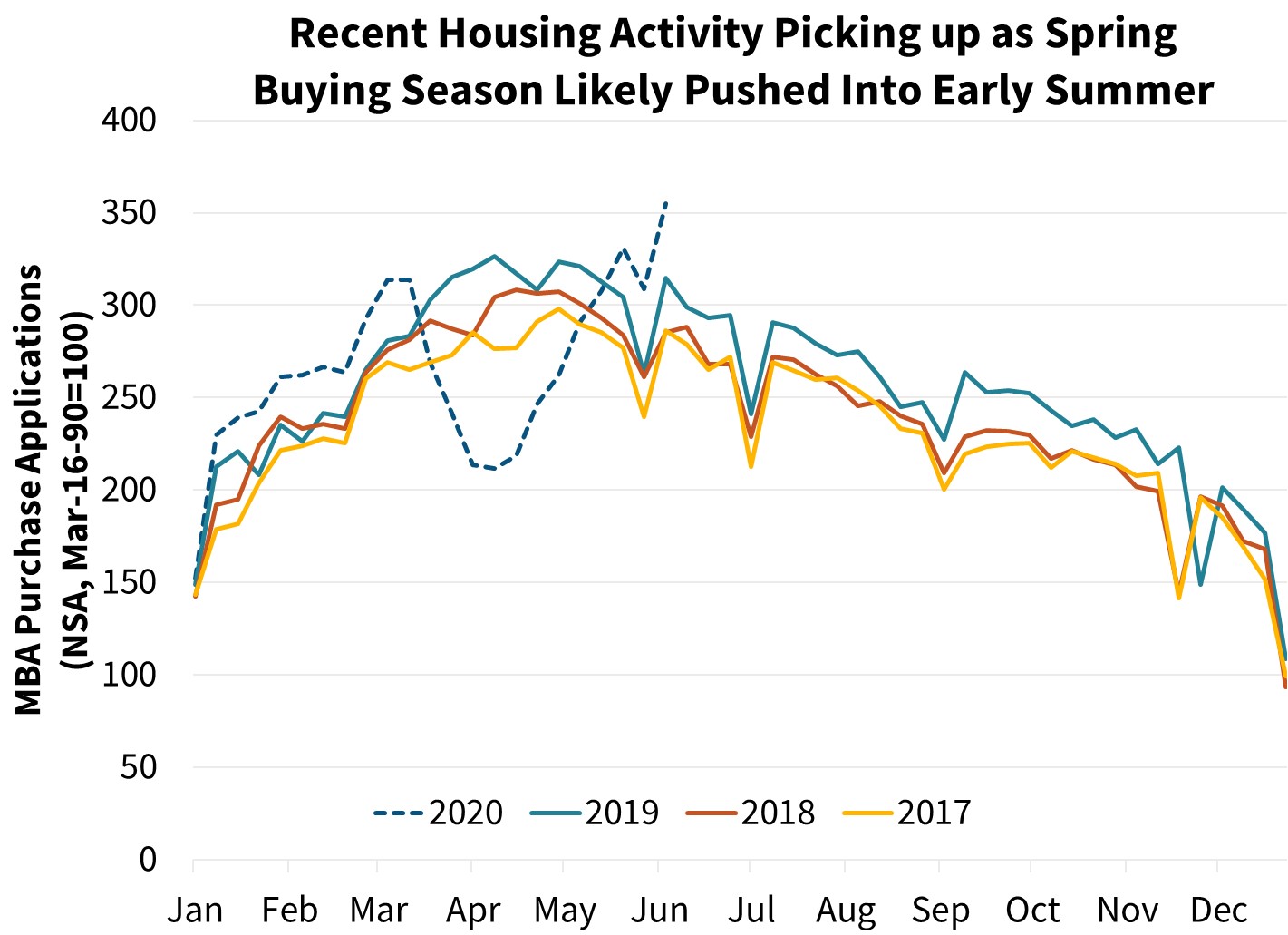
We do not believe that the recent strength in sales will be sustained, however. The pace of new listings continues to be slow relative to prior years, down 19 percent for the week ending June 6 compared to the same week in 2019, according to CoreLogic, and will limit the ability of sales to increase significantly during the next couple months. Combined with a lessening of pent-up demand, we project sales activity to cool somewhat as the summer progresses, and as the reality of an elevated unemployment rate limits potential sales. Thus, we forecast the sales pace to pull back in the fourth quarter before making a gradual further recovery in 2021 as the overall economy improves.
Diverging from the path of existing sales, new home sales edged up in April, in contrast to our expectation of a large decline. Temporary discounting by homebuilders designed to move inventories likely supported sales during this time, as evidenced by the median sales price falling 8.6 percent year over year. However, as described further below, we believe that a divergence has developed between existing and new home sales dynamics.
While both home buying and selling sentiment ticked up in May, the Fannie Mae Home Purchase Sentiment Index® (HPSI) showed that buying sentiment remained comparatively strong relative to selling sentiment. Those reporting it is a good time to buy were 52 percent, down only 7 points since February. In contrast, those saying it’s a good time to sell were 32 percent, down by a larger 35 points over the same period. Buyers continue to be supported by low mortgage rates, while selling attitudes are held back by owners’ beliefs that economic conditions are unfavorable. However, consumer confidence surveys suggest that households are comparatively confident that economic conditions will soon improve. If that is the case, it could support current buyer demand, while sellers concurrently believe they will receive a better offer if they wait. Sellers are also likely hesitant to showcase their homes due to coronavirus avoidance. This combination of factors has driven a widening gap between new listings of existing homes and purchase demand.
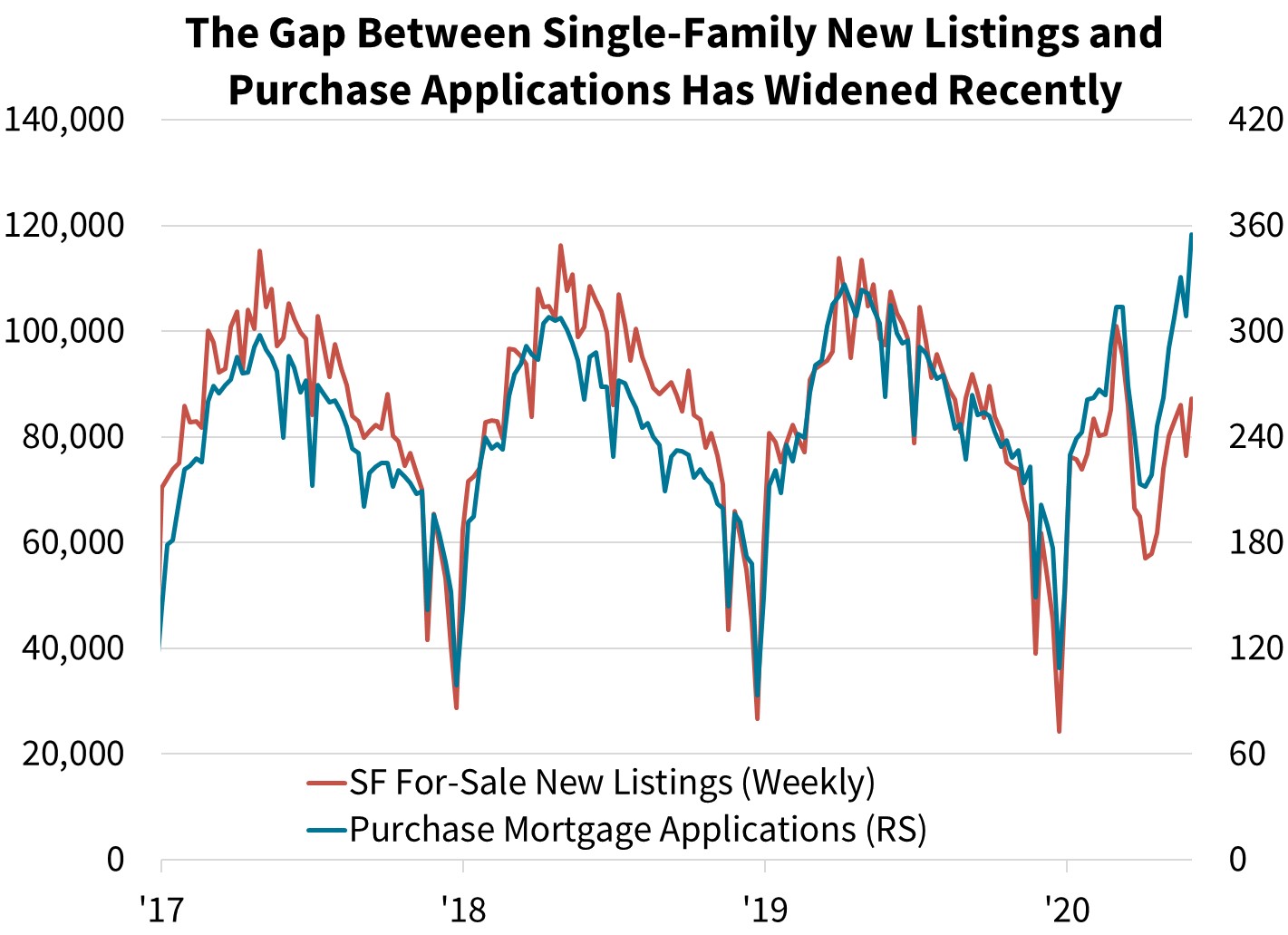
We expect the gap to close as the sales pace pulls back and listings tick up, but, in the meantime, this is supportive for new home sales as a substitute. Homebuilders are less burdened by infection worries and have greater incentive to move product in the short run. Consistent with this theory, roughly half of lost residential construction jobs in March and April were recovered on net in the May employment report, suggesting home building activity is rebounding comparatively quickly.
A geographic skew also exists between new and existing home sales. New sales disproportionately occur in suburban and exurban areas, as well as in the South and non-California West. These geographies have generally experienced less severe coronavirus outbreaks, had less restrictive state-level social distancing rules, and are more auto-oriented, reducing the drag on economic activity from greater fear of using public transportation.
We significantly revised upward our near-term outlook for new single-family home sales, including an increase in our second quarter number to 680,000 annualized units. While this still implies a decline from the first quarter, compared to a year ago it is a 3 percent increase for the quarter. New home sales should continue on solid footing, but homebuilders will soon have to increase the pace of construction to catch up with sales, which will likely reverse recent discounting. A disproportionately high share of sales in April were for homes not yet started. Meanwhile, as listings of existing homes available for sale begin to rise along with the broader economic recovery, the outsized demand for new homes should soften.
Multifamily construction fell in April as well, with starts falling 40 percent to 241,000 annualized units, in line with our expectation. We continue to forecast a comparatively weak recovery in multifamily construction relative to single-family, in part due to geographic differences in their respective footprints. Multifamily is more concentrated in urban areas, as well as the Northeast and West Coast, places more heavily affected by coronavirus shutdowns, while the lead times on construction projects and permitting are also greater. We revised downward our forecast for multifamily starts in 2020 to 332,000, an annual decline of 18 percent, followed by a modest recovery of 3 percent in 2021.
For more on multifamily market conditions please see the June 2020 Multifamily Market Commentary.
Both Redfin and Zillow have recently reported a comparatively large increase in searches by people currently living in large urban areas searching outside their local areas. As remote working arrangements become more common, commuting distance may become less relevant to homebuyers, which could lead to a significant movement of current households out of high-cost metros and central business districts. More generally, if there is a broad reassessment of desired housing features and location amenities, home sales may remain elevated for quite some time relative to what macroeconomic conditions and mortgage rates would suggest. A significant “resorting” could be in the early stages of occurring. If true, new single-family home construction, as well as remodeling expenditures, would benefit, while multifamily housing could experience weakened demand. Home price growth may also vary greatly across local geographic levels and housing types, as the readjustment process occurs. Even if preferences change, the extent to which consumers can act on those shifts depends on personal circumstances, that in turn are affected by macroeconomic conditions. As attitudinal and market data becomes available, we will more explicitly take such preference shifts into account in the housing forecast; currently, they are a source of additional uncertainty.
It’s Likely Going to Be a Big Year for Refinances
We have revised upward our current year forecast for purchase originations this month, consistent with the stronger housing forecast and incoming mortgage applications. We now expect purchase volumes to total $1.2 trillion in 2020, $121 billion higher than last month’s forecast but $75 billion lower than in 2019. We expect purchase volumes to grow by approximately 3.5 percent in 2021 as housing market activity is expected to improve along with the overall economy.
Our refinance originations forecast also increased for the current year based on strong incoming acquisition, securitization, and application volumes. We believe some incoming volume represents activity that has been pulled forward and thus slightly downgraded our refinance outlook for the second half of 2020 and for 2021. Strong refinance volumes are consistent with continued low mortgage rates. According to Freddie Mac, the 30-year fixed rate fell for the fifth consecutive month in May to a new historic low. At 3.18 percent, the mortgage rate during the first week of June, we estimate that approximately 55 percent of all outstanding loan balances have at least a half-percentage point incentive to refinance. This share of “in-the-money” loans rises to around 67 percent if mortgage rates fall to 3.0 percent.
The spread between the 30-year mortgage rate and the 10-year Treasury edged down in May from the April peak of 265 basis points. It remains historically wide, primarily due to lender capacity constraints in the face of large refinance volumes, but we believe it will compress as lenders work through existing demand. According to Fannie Mae’s proprietary Q2 Mortgage Lender Sentiment Survey® (MLSS), which was conducted between May 5 and May 18 (prior to the recent uptick in purchase mortgage application volume), lenders expect increased profitability in the near-term, mainly driven by refinance demand. Despite this optimism, for the first time in survey history more lenders believe the economy is on the wrong track rather than the right track, and a majority of surveyed lenders tightened credit standards.
Other potential mitigating factors to refinance demand include the level of forbearance requests made by current borrowers and borrower transition from forbearance to refinance. However, due to uncertainty around the magnitude of these effects, our forecast has not been explicitly adjusted to account for these factors.
Economic & Strategic Research (ESR) Group
June 10, 2020
For a snapshot of macroeconomic and housing data between the monthly forecasts, please read ESR's Economic and Housing Weekly Notes.
Data source for charts: Google Trends, Johns Hopkins CSSE, Mortgage Bankers Association, Bureau of Labor Statistics, Fannie Mae ESR Group.
Opinions, analyses, estimates, forecasts and other views of Fannie Mae's Economic & Strategic Research (ESR) Group included in these materials should not be construed as indicating Fannie Mae's business prospects or expected results, are based on a number of assumptions, and are subject to change without notice. How this information affects Fannie Mae will depend on many factors. Although the ESR group bases its opinions, analyses, estimates, forecasts and other views on information it considers reliable, it does not guarantee that the information provided in these materials is accurate, current or suitable for any particular purpose. Changes in the assumptions or the information underlying these views, including assumptions about the duration and magnitude of shutdowns and social distancing, could produce materially different results. The analyses, opinions, estimates, forecasts and other views published by the ESR group represent the views of that group as of the date indicated and do not necessarily represent the views of Fannie Mae or its management.
ESR Macroeconomic Forecast Team
- Doug Duncan, SVP and Chief Economist
- Eric Brescia, Economist
- Rebecca Meeker, Financial Economist
- Mark Palim, VP and Deputy Chief Economist
- Nick Embrey, Economist
- Richard Goyette, Business Analyst
